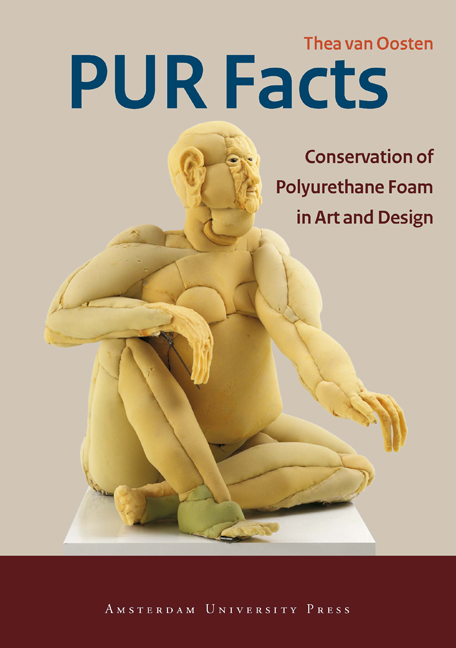Book contents
- Frontmatter
- Contents
- Preface
- Introduction
- 1 Polyurethanes, Manufacture and Applications
- 2 Chemistry, Properties and Degradation
- 3 History of Polyurethane foam Conservation
- 4 Ageing Behaviour of Polyurethane foam
- 5 Assessing the Condition of Polyurethane foam
- 6 Case Studies
- Acknowledgements
- Glossary
- General Information
- Bibliography
4 - Ageing Behaviour of Polyurethane foam
Published online by Cambridge University Press: 14 January 2021
- Frontmatter
- Contents
- Preface
- Introduction
- 1 Polyurethanes, Manufacture and Applications
- 2 Chemistry, Properties and Degradation
- 3 History of Polyurethane foam Conservation
- 4 Ageing Behaviour of Polyurethane foam
- 5 Assessing the Condition of Polyurethane foam
- 6 Case Studies
- Acknowledgements
- Glossary
- General Information
- Bibliography
Summary
It is a known fact (see also Chapter 2, degradation) that polyether urethanes are more sensitive to oxidation and photo-degradation than polyester urethanes. A higher resistance to light can be achieved by incorporating antioxidants and UV absorbers. The best light-resistant polyurethanes are those made from polyester and an aliphatic diisocyanate. As it progressed, the ICN research project began to confirm that polyurethane ester foam is generally more sensitive to hydrolysis whereas polyurethane ether foam is more sensitive to oxidation. Test samples of polyurethane foam were subject to artificial light and thermal ageing. Samples (5 x 5 cm) were cut from large sheets of both polyester and polyether urethane foam. Both sheets had a thickness of 2.5 cm and were obtained from ‘Caligen’ (now Vitafoam), a polyurethane manufacturer.
Materials and methods
POLYURETHANE ETHER FOAM
The polyurethane ether foam sheet was light yellow in colour, and the foam was supple and elastic. When compressed, the foam immediately regained its original position. Under the microscope, the cells were irregular, and their sizes varied from 0.2 – 1 mm. Most of the walls between the cells were open, but about 25% were closed.
POLYURETHANE ESTER FOAM
At the time of our experiments, polyurethane ester foam sheet for our tests was only available in a dark anthracite-like shade of grey. In the factory, each type of polyurethane foam is produced separately (see chapter on manufacturing polyurethane foams). The foam was supple but denser than the ether type. When compressed, the foam immediately regained its original position. Under the microscope, the size of the cells was more regular than those of the ether foam. Their diameter varied approximately from 0.2 to 0.5 mm. As in the ether foam, some of the walls between the cells were closed, but most of them were open.
ARTIFICIAL LIGHT AGEING (XENOTEST)
All polyurethane test samples – both polyurethane ether and ester urethane foam test samples – were artificially light aged using a Xenotest Alpha High Energy (Atlas®) and exposed to the radiation of a filtered Xenon Arc lamp (105 Klx, 50°C, 40% RH) for up to 216 hours to induce photo-oxidation. Test samples were examined for discolouration and surface changes at 0, 4, 8, 16, 24, 48, 72, 96, 120 and 216 hours.
- Type
- Chapter
- Information
- PUR FactsConservation of Polyurethane Foam in Art and Design, pp. 57 - 80Publisher: Amsterdam University PressPrint publication year: 2011
- 1
- Cited by



